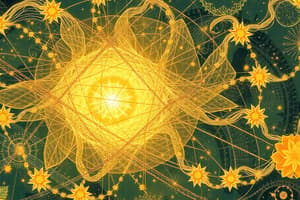Podcast
Questions and Answers
What unit is used to measure energy?
What unit is used to measure energy?
- Watt (W)
- Joule (J) (correct)
- Newton (N)
- Kilogram (kg)
Which constant represents the speed of light?
Which constant represents the speed of light?
- 6.674 x 10^-11 N(m²/kg²)
- 9.81 m/s²
- 6.626 x 10^-34 J·s
- 3.00 x 10^8 m/s (correct)
In which field is medical physics applied?
In which field is medical physics applied?
- Planetary motion
- Studying dark matter
- Medical technologies like radiation therapy (correct)
- Building bridges
What is the standard unit of mass in the metric system?
What is the standard unit of mass in the metric system?
Which application is associated with astrophysics?
Which application is associated with astrophysics?
What is the formula for calculating kinetic energy?
What is the formula for calculating kinetic energy?
Which of the following correctly describes Newton's Second Law?
Which of the following correctly describes Newton's Second Law?
What type of wave requires a medium to travel through?
What type of wave requires a medium to travel through?
What does the First Law of Thermodynamics state?
What does the First Law of Thermodynamics state?
How is electric current defined?
How is electric current defined?
Which principle describes that energy transformations are not 100% efficient?
Which principle describes that energy transformations are not 100% efficient?
In what scenario does Newton's Third Law apply?
In what scenario does Newton's Third Law apply?
What happens to the entropy of a perfect crystal as temperature approaches absolute zero?
What happens to the entropy of a perfect crystal as temperature approaches absolute zero?
Flashcards are hidden until you start studying
Study Notes
Fundamental Concepts
- Matter: Anything that has mass and occupies space.
- Energy: Capacity to do work; exists in various forms (kinetic, potential, thermal, etc.).
- Force: An interaction that changes the motion of an object; measured in Newtons (N).
- Motion: The change in position of an object over time, described by speed, velocity, and acceleration.
Laws of Motion
- Newton's First Law: An object at rest stays at rest, and an object in motion stays in motion unless acted upon by a net external force.
- Newton's Second Law: The acceleration of an object is directly proportional to the net force acting on it and inversely proportional to its mass (F = ma).
- Newton's Third Law: For every action, there is an equal and opposite reaction.
Energy Principles
- Kinetic Energy (KE): Energy of motion; KE = 1/2 mv², where m is mass and v is velocity.
- Potential Energy (PE): Stored energy due to position; gravitational PE = mgh, where h is height above a reference point.
- Conservation of Energy: Energy cannot be created or destroyed, only transformed from one form to another.
Waves and Oscillations
- Wave: A disturbance that travels through space and matter; characterized by wavelength, frequency, amplitude, and speed.
- Types of Waves:
- Mechanical Waves: Require a medium (e.g., sound waves).
- Electromagnetic Waves: Do not require a medium (e.g., light waves).
- Frequency (f): Number of cycles per second, measured in Hertz (Hz).
- Period (T): Time taken for one complete cycle, T = 1/f.
Thermodynamics
- First Law: Energy cannot be created or destroyed (conservation of energy).
- Second Law: Entropy of an isolated system never decreases; energy transformations are not 100% efficient.
- Third Law: As temperature approaches absolute zero, the entropy of a perfect crystal approaches zero.
Electricity and Magnetism
- Electric Charge: Property of particles; two types: positive and negative. Like charges repel; opposite charges attract.
- Circuit: A closed loop through which electric current can flow.
- Ohm's Law: V = IR, where V is voltage, I is current, and R is resistance.
- Magnetic Fields: Area around a magnet where magnetic forces can be experienced.
Modern Physics
- Relativity: Theory by Einstein; introduces concepts of time dilation and length contraction as speeds approach the speed of light.
- Quantum Mechanics: Describes physical phenomena at microscopic scales; incorporates the idea of quantization of energy.
Key Units
- Mass: Kilogram (kg)
- Length: Meter (m)
- Time: Second (s)
- Force: Newton (N)
- Energy: Joule (J)
- Power: Watt (W)
Important Constants
- Speed of Light (c): Approximately 3.00 x 10^8 m/s
- Gravitational Constant (G): 6.674 x 10^-11 N(m²/kg²)
- Planck's Constant (h): 6.626 x 10^-34 J·s
Practical Applications
- Engineering: Principles of physics are applied in designing structures, machines, and technology.
- Astrophysics: Understanding the universe's mechanics, from planetary motion to cosmology.
- Medical Physics: Application of physics principles in medical technologies (e.g., imaging, radiation therapy).
This structure outlines key concepts within the subject of physics for a streamlined review.
Fundamental Concepts
- Matter is anything that has mass and occupies space.
- Energy is the capacity to do work and exists in various forms like kinetic, potential, thermal, and more.
- Force is an interaction that changes the motion of an object and is measured in Newtons (N).
- Motion is the change in position of an object over time, described by speed, velocity, and acceleration.
Laws of Motion
- Newton's First Law: An object at rest stays at rest, and an object in motion stays in motion at a constant velocity unless acted upon by a net external force.
- Newton's Second Law: The acceleration of an object is directly proportional to the net force acting on it and inversely proportional to its mass (F = ma).
- Newton's Third Law: For every action, there is an equal and opposite reaction.
Energy Principles
- Kinetic Energy (KE): Energy of motion; KE = 1/2 mv², where m is mass and v is velocity.
- Potential Energy (PE): Stored energy due to position; gravitational PE = mgh, where h is height above a reference point.
- Conservation of Energy: Energy cannot be created or destroyed, only transformed from one form to another.
Waves and Oscillations
- Wave: A disturbance that travels through space and matter; characterized by wavelength, frequency, amplitude, and speed.
- Mechanical Waves: Require a medium (e.g., sound waves).
- Electromagnetic Waves: Do not require a medium (e.g., light waves).
- Frequency (f): Number of cycles per second, measured in Hertz (Hz).
- Period (T): Time taken for one complete cycle, T = 1/f.
Thermodynamics
- First Law: Energy cannot be created or destroyed, only transformed from one form to another.
- Second Law: Entropy of an isolated system never decreases; energy transformations are not 100% efficient.
- Third Law: As temperature approaches absolute zero, the entropy of a perfect crystal approaches zero.
Electricity and Magnetism
- Electric Charge: Property of particles; two types: positive and negative, like charges repel; opposite charges attract.
- Circuit: A closed loop through which electric current can flow.
- Ohm's Law: V = IR, where V is voltage, I is current, and R is resistance.
- Magnetic Fields: Area around a magnet where magnetic forces can be experienced.
Modern Physics
- Relativity: Theory by Einstein; introduces concepts of time dilation and length contraction as speeds approach the speed of light.
- Quantum Mechanics: Describes physical phenomena at microscopic scales; incorporates the idea of quantization of energy.
Key Units
- Mass: Kilogram (kg)
- Length: Meter (m)
- Time: Second (s)
- Force: Newton (N)
- Energy: Joule (J)
- Power: Watt (W)
Important Constants
- Speed of Light (c): Approximately 3.00 x 10^8 m/s
- Gravitational Constant (G): 6.674 x 10^-11 N(m²/kg²)
- Planck's Constant (h): 6.626 x 10^-34 J·s
Practical Applications
- Engineering: Principles of physics are applied in designing structures, machines, and technology.
- Astrophysics: Understanding the universe's mechanics, from planetary motion to cosmology.
- Medical Physics: Application of physics principles in medical technologies (e.g., imaging, radiation therapy).
Studying That Suits You
Use AI to generate personalized quizzes and flashcards to suit your learning preferences.




